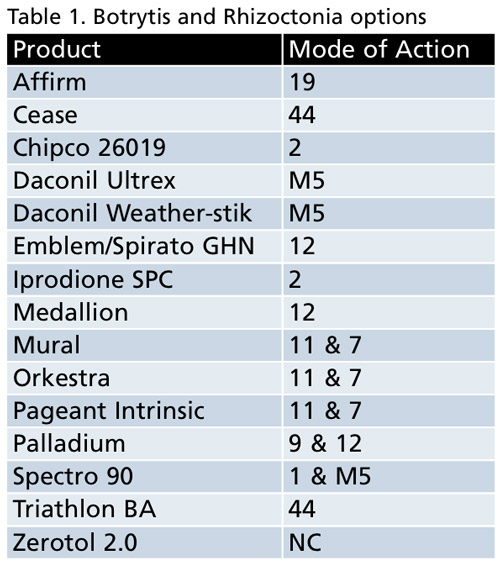12/1/2017
Four Steps to Manage Diseases in Propagation
Rick Yates
Warm and humid conditions in the propagation area aren’t only good for seed germination and rooting cuttings, they can also provide a suitable environment for disease development. What follows is a checklist of practical steps that can be taken to minimize disease risks.
1. Sanitation remains the front line of defense. The propagation area should be weed-free at all times. Properly timed applications of Marengo pre-emergent herbicide can provide months of effective control. Before the start of propagation, all surfaces should be cleaned and then disinfected. Strip-it is an example of a high-powered cleaner designed to remove organic and mineral deposits from floors, benches, sidewalls, tools and other surfaces. Follow up the thorough cleaning with a true sanitizer, such as KleenGrow, Sanidate 5.0, X3 or Zerotol 2.0. Start clean!
 2. Optimize mist systems to ensure that the minimum amount of mist is provided to satisfy the needs of seeds and cuttings. Work with your supplier to ensure your mist nozzles are the best choice for your application and that your system is operating at peak effectiveness. A high-quality surfactant, such as CapSil, can be used to break surface tension on leaf surfaces, contributing to a more even distribution of mist droplets; less water use and faster rooting often result. Lightweight row-cover fabrics, such as Agrofabric Pro 17, have been used in certain situations to reduce or eliminate the need for mist all together.
2. Optimize mist systems to ensure that the minimum amount of mist is provided to satisfy the needs of seeds and cuttings. Work with your supplier to ensure your mist nozzles are the best choice for your application and that your system is operating at peak effectiveness. A high-quality surfactant, such as CapSil, can be used to break surface tension on leaf surfaces, contributing to a more even distribution of mist droplets; less water use and faster rooting often result. Lightweight row-cover fabrics, such as Agrofabric Pro 17, have been used in certain situations to reduce or eliminate the need for mist all together.
3. Start with clean cuttings and seeds. If stock plants are produced on-site, you can maintain strict protocols to reduce disease risk. Most of us bring in unrooted cuttings, making the selection of suppliers very important. While even the best stock farms can have a problem, sticking with reputable sources that have a good track record of supplying clean cuttings can reduce risks. Seeds can also harbor fungal and bacterial diseases, so the same advice applies to seed suppliers.
4. Fungicides and bactericides can still be required even when all other disease reduction steps have been successfully implemented. Proper sanitation and optimized mist conditions will make fungicide applications more effective, all other factors being equal. Crops vary in their disease susceptibility, making it worthwhile to learn as much as possible about the crops you produce.
Botrytis and Rhizoctonia are two of the most common diseases that occur in propagation. Botrytis has a particularly well-deserved reputation for developing resistance to fungicides. A strong rotation is essential to reduce resistance pressure. Contact your supplier for help with formulating rotations that consider both plant safety and efficacy.
Table 1 shows a partial list of effective fungicides that control Botrytis and Rhizoctonia. Always read and follow all label directions. Pesticides other than those mentioned here may also be safe and effective. Some of the fungicides listed below are not registered for use in all states. GT